“Just want to slice a bit of fruit.” “Need to trim a small piece of meat.” “Working in a tight kitchen sink.” — In those moments, having a petty knife at hand can make cooking feel a lot easier.

On the other hand, some say “you don’t need a petty knife, a Santoku is enough.” I have to admit, I thought the same at first. But once I got into cooking and started using this small but mighty knife, I fell in love with its versatility.
This article will explain the true petty knife uses, how it differs from a fruit/paring knife, and address questions like “Can I use it for meat or fish?” or “If I live alone, is one petty knife enough?” We’ll also cover some recommended models and tips on choosing the right one. By the end, you’ll see how a petty knife can make your kitchen life a bit more enjoyable!
(If you’re looking for specific petty knife product recommendations, we’ve got a section on that too. Read on!)

What Is a Petty Knife? Explaining Differences from a Paring Knife
Petty Knife Definition
- A petty knife is a small Japanese utility knife, typically with a blade length of about 9–15 cm (around 4–6 inches). It’s mainly suited for cutting fruits, small vegetables, decorative carving, and other fine-detail tasks in the kitchen. In essence, it’s a compact all-purpose knife.
- Petty knives also feature well-designed handles for comfort and control. In fact, many professional chefs love to use a petty knife as a secondary helper knife due to its nimble handling.
How Is It Different from a Paring (Fruit) Knife?
A fruit knife (often equivalent to a paring knife in Western kitchens) is even smaller and simpler than a petty knife. Here’s a quick comparison:
| Item | Fruit Knife (Paring Knife) | Petty Knife |
|---|---|---|
| Blade Length | ~7–10 cm (very small) | ~9–15 cm (somewhat longer) |
| Intended Use | Peeling and cutting fruit only | From fruit prep to vegetable prep, garnishing, etc. (more wide-ranging) |
| Handle | Often very simple/plain handle | Can have professional-grade handles designed for comfort |
| Characteristics | Really feels like a “fruit-only” knife | A more versatile “fruit knife + α,” essentially a small all-purpose knife |
While a fruit knife is perceived as a dedicated tool just for fruits, a petty knife has a broader scope. You can think of the petty knife as a “small all-purpose knife” that can maneuver in many situations. Its range extends beyond fruits to veggies, herbs, and more, making it far more handy in day-to-day cooking.
Petty Knife vs. Santoku – Which Should You Use?
Differences Between a Petty Knife and a Santoku Knife
First, let’s summarize the differences in a table:
| Aspect | Petty Knife | Santoku Knife |
|---|---|---|
| Blade Length | Typically 10–15 cm (4–6 inches) | Generally around 16–18 cm (6–7 inches) |
| Blade Shape | Narrow, long blade. The tip is pointed sharp, and the handle is smaller. | Wider blade with a slightly curved tip. Longer blade length, medium thickness. |
| Uses | – Peeling small fruits or vegetables, making decorative cuts.– Fine preliminary prep and trimming work.– Cutting meat tendons or slicing small portions, etc. | – An all-rounder that can broadly cut meat, fish, and vegetables.– Useful in all kinds of cuisine (Japanese, Western, Chinese, etc.).– Can even handle larger ingredients. |
| Characteristics | – Lightweight and easy to handle, great for detailed work.– The tip is very sharp, making it excel at delicate tasks like removing fruit stems or intricate carving. | – True to its name “Santoku” (meaning “three virtues”), it can handle meat, fish, and vegetables equally well.– The blade’s width makes ingredients easy to cut and gives a large contact area on the cutting board. |
| Advantages | – Highly maneuverable, making fine cuts easy.– Very light, so there’s little strain on the wrist.– Perfect for tasks like peeling fruit or small prep work. | – Can be used for a wide range of tasks as a genuine all-purpose knife.– Longer blade can slice through large ingredients in one go.– Versatile and accessible for everyone from beginners to pros. |
| Disadvantages | – Short blade and narrow width, so not suitable for large ingredients or big batch cooking.– Not ideal for heavy-duty work that requires force (e.g. cutting hard squash or through bone-in meat). | – Not as nimble as a petty knife, so it’s less suited to very fine detailed work.– The knife is relatively large and on the heavy side, which can be a bit unwieldy for smaller hands. |
| Recommended Uses | – Cutting fruits or small vegetables.– Garnishing (making decorative cuts).– Quick peeling or trimming tasks. | – As the main kitchen knife for home use.– When you need to handle a bit of everything: meat, fish, and vegetables.– A general-purpose knife that’s easy for even beginners to use. |
| Common Materials | Stainless steel (e.g. VG10), carbon steel (e.g. Blue Paper steel). | Stainless steel (e.g. molybdenum steel, VG10), carbon steel (Blue Paper, White Paper steel, etc.). |
| Choosing Points | – Great for those who prioritize light weight and easy handling.– Useful to have as a secondary knife in your kit.– A must-have if you frequently work with fruits or do intricate decorative cutting. | – If you want one main knife for home use, a Santoku is the top recommendation.– Handles a wide variety of cooking tasks in an all-purpose manner.– Its well-balanced design makes it easy to use even for beginners. |
Much Overlap: Why Do Some People Say “Just Use a Santoku”?
If you already have a Santoku that can do most tasks, a petty knife might seem too small and limited in use. Indeed, many cooks wonder “Is it really worth buying an extra knife?” and feel a petty knife might not be necessary.
But let’s put it this way: the Santoku is a fantastic all-purpose knife, and by that logic you might think no other knives are needed at all. People determined to “get by with just a Santoku” might consider even researching a petty knife a waste of time.
(For comparison of Santoku with other knives, see our related guides on Santoku vs Gyuto, etc.)
If You’re Not Used to It, You Might Mistake It for a Fruit Knife
Some also say, “In the end, if it’s only good for peeling fruit, maybe I don’t need it?” However, a petty knife shines in those fine tasks that a Santoku is clumsy at. For cooks with smaller hands, a Santoku might feel unwieldy, whereas a petty knife can be surprisingly handy.
It’s also worth knowing that a petty knife actually plays a role when breaking down meat or fish (more on this later). Personally, I find having one is definitely convenient, and I never really understood the rush to dismiss it as unnecessary.
Other Reasons from the “Don’t Need It” Camp
- Don’t want to take up more storage space.
- Don’t want additional knives to sharpen/maintain.
It’s true that storage can be an issue — that concern is understandable. If your kitchen space is tight or other knives take priority, you shouldn’t force yourself to add another knife. And if extra maintenance sounds like a headache, then by all means, stick to just a Santoku to cover everything. Nobody is forcing you to buy a petty knife.
Living Alone: Is Having Only a Petty Knife Enough?
If you live by yourself, can you get by with just a petty knife? Absolutely — it’s totally possible. In fact, if you don’t have family members around, you might dine out more often, and if you’re not cooking with friends or family, you might find you don’t even need a petty knife (or any special knife) in the first place. And for those who love cooking despite living solo, you probably wouldn’t be on the fence about getting one anyway.
That said, here are the pros and cons of relying on a petty knife as your only knife when you’re living alone:
Pros
- No storage issues due to its compact size — it slips right into a small kitchen drawer or a tiny kitchen space without a problem.
- Handles veggies, fruits, and small meat prep just fine — in fact, for someone who doesn’t cook often, a petty knife can be “just enough” for most simple tasks.
- Works well even in a cramped kitchen — the petty knife’s short blade lets you make full use of a small cutting board or sink area without bumping into things.
- Easy to clean and care for — being smaller, it’s quicker to wash than a big chef’s knife. A quick rinse and wipe dry is usually all it takes to keep it clean and ready.
Cons
- Hard to cut large ingredients (like a pumpkin) — the more your cooking repertoire grows, the more a petty knife alone will feel limiting. It can be tough to tackle serious prep of big cuts of meat or whole fish with just this knife.
Can You Cut Meat and Fish with a Petty Knife? (Petty Knife Uses by Scenario)
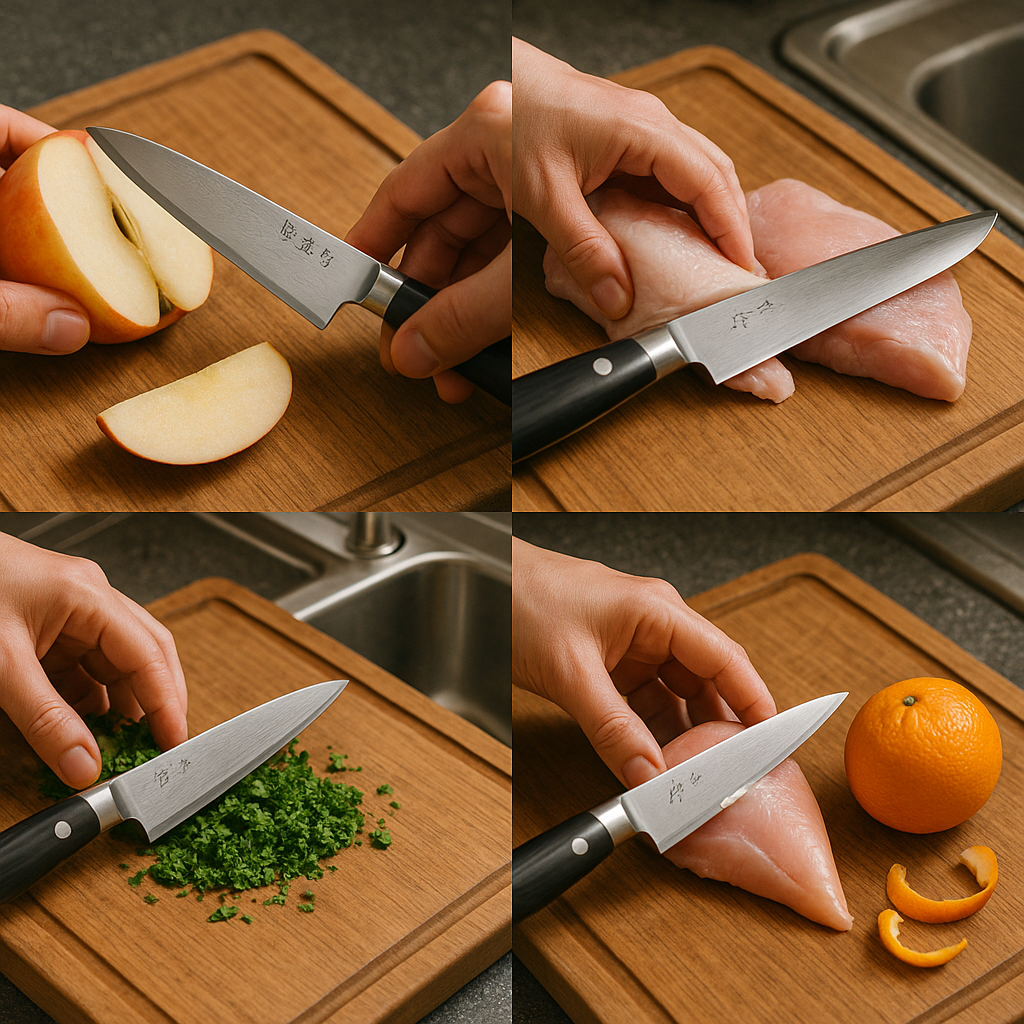
I actually wondered about this myself and decided to push the limits of what a petty knife can do. The result? It turned out to be a surprisingly strong ally. The petty knife’s compact blade can get into the nooks and crannies of meat or fish, making it easy to snip out tendons or excess fat with precision.
In other words, it’s great for tasks that might be awkward with a big knife. Let’s explore some common scenarios and see how the petty knife performs in each:
Cutting Meat
- Small cuts or trimming sinew – Ideal. For example, trimming a small piece of meat or removing silverskin/skin (like taking the skin off a chicken breast) is where the petty knife excels. Its size gives you fine control.
- Breaking down large bone-in or big cuts – Lacks power. A petty knife doesn’t have the heft or length to easily butcher large roasts or cut through bones. For a big bone-in pork shoulder or a whole chicken, it will feel underpowered.
Cutting Fish
- Preparing small fish or skinning fillets – Possible. The petty knife can handle tasks like gutting and prepping small fish (e.g. cleaning an anchovy or sardine) or even skinning a fillet. For instance, tidying up the shape of a salmon fillet or removing its skin is doable with some care.
- Filleting large fish or cutting thick bones – Not suitable. For large fish that require a full fillet (three-piece filleting) or for chopping through thick fish bones, a petty knife isn’t the right tool. These jobs require more length and strength (usually a dedicated fillet or heavier knife).
Other Ways to Use a Petty Knife (Fruits, Vegetables, Kids Helping Out)
Peeling Fruit & Decorative Vegetable Cutting
Fruit Peeling: When peeling fruits like apples, kiwis, or oranges, a petty knife’s easily controlled tip allows you to follow the curves of the fruit and peel very thinly. It’s great for getting just the skin without wasting flesh.
Vegetable Garnishing: Whether it’s carving a pattern into a pumpkin’s skin or cutting a carrot into fancy flower shapes, a petty knife is perfect for delicate decorative work. It lets you add intricate touches that can make your dish presentation much more attractive.
Creating Fruit Platters for Parties
Effortless Bite-Size Cutting: For making a platter of fruits, a petty knife lets you slice fruits into bite-size pieces with ease. Cutting up grapes, strawberries, melon, etc., into uniform small pieces (or making decorative cuts while leaving the skin on) is very handy with this knife.
Final Touches for Presentation: When plating a fruit platter or dessert, you can use the petty knife for the final trimming and tidying. For example, if some fruit pieces have rough edges or uneven cuts, a quick touch-up with the petty knife makes the whole arrangement look neat and beautiful. This ability to do the last little trim is a strength of the petty knife.
Using It in a Household with Children
(Yes, a petty knife can even shine in homes with kids!)
Safe “First Knife” for Kids: Because the blade is short, a petty knife can sometimes fit a child’s hand better than a large Santoku or chef’s knife. Under strict adult supervision, a petty knife is actually a fitting tool for teaching kids how to cut small things (like fruits or soft veggies). It allows children to practice cutting in a more controlled way, making it perfect for that first-time helping in the kitchen experience.
Time-Saver for Lunchbox Prep: When making bento lunches (or any lunchbox) for kids, a petty knife is great for quick, detailed work — like cutting cheese or ham with small cookie cutters, or adding decorative cuts to veggies. These little touches can make an ordinary lunch much more fun and colorful, and the petty knife speeds up the prep of those small ingredients.
Summary: How a Petty Knife Performs in Each Scenario
It’s been a lot of information, so here’s a quick recap of the petty knife’s role in various situations:
Cutting Meat
- Excellent for trimming small pieces of meat or removing sinew/skin (e.g. taking the skin off a chicken breast).
- Insufficient power for cutting through bone-in meat or large blocks of meat.
Cutting Fish
- Can handle prep of small fish (like cleaning sardines or scaling small fish) and skinning fillets (e.g. tidying up a salmon fillet).
- Not suited for filleting large fish or cutting through hard fish bones.
Peeling Fruit & Vegetable Garnishing
- Allows you to peel skins of apples, kiwis, oranges, etc. very thinly and neatly.
- Great for carving patterns in vegetable skins or cutting carrots into decorative shapes, enhancing food presentation.
Fruit Platters at Parties
- Useful for cutting grapes, strawberries, melons, etc. into bite-size pieces or making decorative cuts while keeping the skins on.
- Also handy for the final trimming of fruits to achieve a beautiful presentation on the platter.
In Households with Kids
- Short blade and easy handling make it suitable as a “first knife” for kids to practice cutting small foods (always with adult supervision).
- Speeds up fine-detail prep like cutting cute shapes out of cheese or ham, or decorative cuts in veggies, which adds fun and saves time when preparing kids’ meals.
Petty Knife Recommendations: Choosing by Size and Blade Length
Now, let’s talk about choosing the right petty knife. There are many models out there — how do you pick one that suits your needs?
Here are some key points and recommendations, especially focusing on blade size, since petty knives come in a range from small to relatively large.
Points for Choosing
- Blade Length: A blade around 10–13 cm (4–5 inches) tends to be the easiest to handle for most people. This length offers a good balance between agility and utility. Shorter than that gets closer to a paring knife; longer starts to approach a small chef’s knife.
- Handle Material: Knives with a full stainless steel construction or resin (plastic) handle are excellent in terms of hygiene and easy upkeep. Wooden handles, on the other hand, provide a comfortable grip and a traditional feel — it really comes down to personal preference. Choose a handle that feels good in your hand and fits your maintenance style.
- Blade Steel:
- Stainless Steel: Resists rust and is generally easy to maintain. Great for most home cooks who want a fuss-free experience.
- Carbon Steel: Offers top-notch sharpness and edge retention, but requires more care (it can rust if not dried properly). Best for those who don’t mind regular maintenance and sharpening, and who want the ultimate sharp edge.
(Tip: If you’re unsure about steel types, stainless is usually a safer bet for beginners due to its low maintenance. Carbon steel is amazing for sharpness but be prepared to oil and wipe your knife often.)
Petty Knife Size Guide (Blade Length 9–15 cm): What’s the Difference?
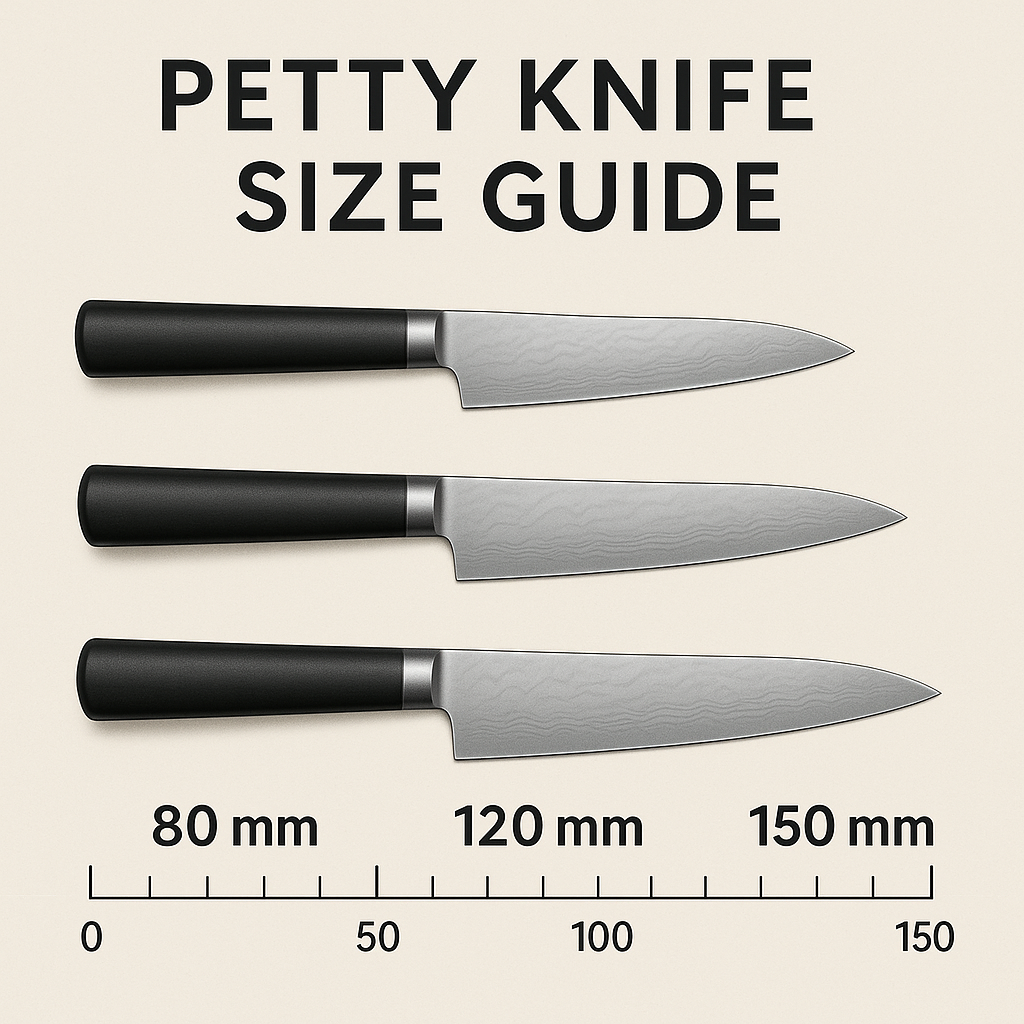
You might hear phrases like “petty knives are about 9–15 cm” or “around 10–13 cm is the most user-friendly.” If you’re new to this, those numbers can be hard to visualize. Here’s a quick guide to how different blade lengths affect the petty knife’s use:
| Blade Length (approx.) | Recommended For… | Main Benefits | Cautions / Drawbacks |
|---|---|---|---|
| ~10 cm (under 10 cm is often called a “paring knife”) | – People who primarily cut fruits or very small veggies.– Those with small hands or a weaker grip.– Cooks who do a lot of delicate garnish work. | – Extremely compact and easy to control.– Best for fruit peeling and very fine decorative cutting. | – Lacks power for larger ingredients (daikon, pumpkin, etc.).– In many cases you’ll still need to use a larger Santoku alongside. |
| ~12 cm | – Anyone who wants to reasonably cover veggies, meat, and fruit prep with one knife.– Great as a secondary knife or for someone living alone. | – Still nimble, yet more versatile than a 10 cm blade.– Can even handle trimming meat or prepping small fish to some extent. | – Still not entirely confidence-inspiring for big ingredients.– When storing, consider using a blade cover or a separate slot (since it’s longer than a paring knife). |
| ~15 cm | – Those who want to do most of their cooking tasks with a smaller, lighter knife.– Cooks looking to lighten the weight of their everyday knife. | – On the larger side for a petty knife, so it can handle some meat cutting and small fish cleaning as well.– Still capable of fruit and garnish work despite the extra length. | – Can be a bit cumbersome for people with very small hands.– In heavy-duty tasks, it may still lose out to a full-size Santoku or chef’s knife in power. |
~10 cm Range: Specialized for Finer Cuts
- If your main tasks are peeling fruit or doing garnishing and you find larger knives unwieldy, a ~10 cm petty knife will suit you perfectly. It’s the ideal choice when a big knife feels like overkill for a delicate job.
- Thanks to its small size, it takes up almost no space. Even if your cutting board or sink area is tiny, you can maneuver a 10 cm petty knife smoothly without bumping into things.
~12 cm Range: A Well-Balanced All-Rounder
- Around 12 cm is considered the most balanced, all-purpose size for a petty knife. It’s still easy to handle for peeling and trimming, but also long enough to tackle small chopping or slicing tasks. If you want a petty knife that offers a bit more versatility (yet remains nimble), this size is spot-on.
- For someone living alone, a two-knife setup of “12 cm petty + Santoku” can cover almost all cooking needs. The petty handles the small stuff and fine work, while the Santoku covers the heavy lifting — together they’re a great combo.
~15 cm Range: Slightly Larger and More Capable
- A 15 cm blade is on the longer side for a petty knife, which makes it suitable for those who want their petty knife to handle some meat slicing or small fish butchery in addition to the usual small tasks. It bridges the gap toward a chef’s knife while still being lighter and easier to wield.
- However, if your hands are small, this size might feel a bit challenging. The best practice is to actually hold and maybe test the knife in person if possible — check the grip and weight before buying. That way you can ensure it feels comfortable, and you’ll reduce the chance of regret.
In summary, here’s how to choose by size:
- ~10 cm: Best if you prioritize fruit peeling and decorative work, and it’s also a great choice if you have small hands.
- ~12 cm: The most well-balanced “medium size.” Perfect as a secondary knife or for a one-knife setup in a small household.
- ~15 cm: Offers the versatility of a petty knife plus a bit more cutting power for larger items. Just make sure you’re comfortable with the slightly larger size (test the grip and weight if you can).
When buying a petty knife, make sure to consider what you’ll use it for and the size of your own hands. If the knife is too large, delicate tasks will become difficult; if it’s too small, it might not be versatile enough for your needs.
Pick an appropriate size and a petty knife will make your everyday cooking more comfortable and even enhance the joy of cooking. With the right petty knife, those little kitchen tasks become smoother, and you might find yourself reaching for it more often than you expected.
Recommended Brand Examples
There are numerous brands offering quality petty knives. Here are a few notable examples (with their general characteristics and price ranges):
| Brand | Features (What Makes Them Stand Out) | Price Range (JPY) |
|---|---|---|
| Kai (KAI) | Wide variety of models from beginner-friendly to professional-grade. Great cost performance for the quality. | Approximately ¥1,000–¥5,000 (affordable) |
| Henckels (Zwilling) | Renowned German brand. Known for good edge retention and a handle design that’s very comfortable to grip. | Around ¥3,000–¥10,000 |
| Global (GLOBAL) | All-stainless one-piece construction, which is hygienic and stylish. Also impressively lightweight, which many users appreciate. | About ¥5,000–¥15,000 |
(Note: Prices above are general ranges in Japanese Yen for petty knives from each brand.)
These brands are popular starting points. For a petty knife, Japanese makers like Kai and Global offer excellent craftsmanship and value, while Western brands like Henckels are also highly regarded for their design and durability.
When choosing, consider the blade size and handle style you prefer, and you’ll likely find a great option among these brands.
Pros and Cons of Using a Petty Knife
For those still asking “Is it really worth buying a petty knife?”, let’s lay out the advantages and disadvantages side by side. Here’s a quick table summing up the pros and cons of owning and using a petty knife:
| Aspect | Merits (Pros) | Demerits (Cons) |
|---|---|---|
| Maneuverability(handling in tight spaces) | – Easy to handle even if you have small hands.– Simple to maneuver even in a cramped area or small cutting space. | – Not suitable for cutting large ingredients (the short blade can’t cover big items well). |
| Fine Detail Work(precision tasks) | – Truly shines for peeling fruit, decorative cutting, and fine vegetable prep – tasks requiring precision. | – Lacks the power for heavy-duty jobs like cutting through bone-in meat or very large fish. |
| Storage Ease(how easy to store) | – Short blade means it doesn’t take up much space in storage. Fits easily in a drawer or knife block slot. | – People who prefer to own only one knife might be reluctant, as it’s an additional item to store (some folks don’t want to “increase the number of knives”). |
| Ease of Sharpening(maintenance effort) | – Because the blade is short, it can be easier and quicker to sharpen on a whetstone (once you get the hang of it). | – The smaller blade requires careful angle control when sharpening; beginners might find it a bit tricky at first to maintain the right angle. |
| Versatility(range of use) | – In home cooking, it’s extremely handy as a secondary knife to complement your main knife. | – Not as broadly versatile as a Santoku; it won’t replace a larger chef’s knife for many tasks. |
In essence, the petty knife is characterized by its role as a “super sub” – a super-helpful substitute player in your kitchen lineup.
Think of it like the utility player on a baseball team who can cover many positions whenever needed. If you’re not strictly a “one knife only” person, having this kind of reliable helper in your kitchen is incredibly reassuring when you’re tackling various tasks.
(In sports terms, the petty knife is like that invaluable backup player who can do it all. It’s the unsung hero that makes the game (cooking, in our case) go smoothly!)
Petty Knife Care & Storage by Material: Tips for Long-Lasting Use
A petty knife may be a “small all-purpose knife,” but precisely because it’s small, proper care and storage are very important to keep it performing well. In this section, we’ll cover how to maintain your petty knife based on its material — mainly the difference between stainless steel knives and carbon steel knives.
We’ll talk about sharpening frequency, preventing rust, and storage methods for each. With just a bit of effort, you can enjoy a razor-sharp edge for a long time, so let’s learn how to take care of this handy tool.
Stainless Steel Petty Knives: Convenient and Low-Maintenance
- As a rule of thumb, sharpen about once a month, or whenever you notice the edge has dulled. Regular light sharpening will keep it performing optimally.
- The sharpening process can be fairly simple: use a medium grit whetstone (around #1000 grit) to sharpen, then finish with a finer stone (#3000–#5000) to polish the edge. That’s usually sufficient to keep a stainless steel petty knife in great shape.
- Be aware that because stainless steel doesn’t rust easily, some people get a bit complacent about sharpening. Don’t fall into that trap—just because it’s stainless doesn’t mean it stays sharp forever. Ideally, touch up the edge before it gets noticeably dull, rather than waiting too long.
- Remember: “stainless” doesn’t mean “never rusts.” Stainless steel is resistant to rust, but it can rust under certain conditions, so don’t neglect basic care.
- After each use, wash the knife promptly and dry it thoroughly. Wipe off all water and avoid leaving it in a damp sink or dish rack for long periods. Store it in a dry place.
- If you won’t be using the knife for an extended period, it’s a good idea to apply a thin coat of cooking oil on the blade. Just a light layer (then wipe most of it off with a paper towel) will create a protective film that further guards against any potential rust during storage.
- Use a knife block, blade guard (cover), or sheath to store your petty knife. The key is to prevent the blade from knocking into other utensils or knives. This not only protects the edge from damage but also protects your hands when reaching into a drawer.
- Avoid just tossing the knife bare into a drawer. If you must store it in a drawer, consider installing a divider or at least using a knife cover on the blade. Direct contact with other tools can dull or chip the petty knife’s fine edge over time.
Carbon Steel Petty Knives: For Those Who Want Ultimate Sharpness
- To maintain the famously sharp edge of a carbon steel petty knife, you’ll want to sharpen it at least once a month, possibly more often if you use it frequently. Carbon steel can take a very keen edge, but you need to upkeep it to enjoy that sharpness.
- The ideal sharpening routine for carbon steel is a bit more involved: Start with a coarse stone (#400–#600) if the blade needs reshaping or if there are small chips, then go to a medium stone (~#1000) to refine, and finish on a fine stone (#3000–#5000) for a truly razor edge. This progression will bring out the best performance in the steel.
- If you’re not confident in your sharpening skills, it might be worth seeking a professional sharpening service or consulting a knife shop. Carbon steel can require more technique to sharpen perfectly, so there’s no shame in getting expert help to maintain that edge, especially for expensive knives.
- Carbon steel is much more prone to rust than stainless. Exposure to water (moisture) or acids can cause it to rust rapidly. The fundamental rule is: wash it immediately after use and dry it completely right away. Never leave a carbon steel knife sitting dirty or wet, even for a little while.
- Pay extra attention after cutting foods that are high in salt or acid (for example, fish with salt, or tomatoes, citrus, etc.). Those can accelerate rusting. If you slice something acidic or salty, rinse and wipe the blade immediately after you’re done — even a short delay can lead to rust spots on carbon steel.
- For long-term storage of a carbon steel petty knife, definitely coat the blade with a thin layer of oil (food-grade mineral oil or even cooking oil works) before putting it away. As with stainless, wipe off the excess so it’s just a light film. This will dramatically reduce the chance of rust forming during storage.
- Never store a carbon steel knife in a damp or sealed environment. Avoid places with a lot of humidity like under the sink, and do not leave it in an airtight container where moisture can get trapped. That’s a recipe for rust.
- It’s best to keep carbon steel knives in something like a cloth knife roll, a sheath, or a knife block. A cloth or leather sheath can absorb a bit of moisture and let air circulate, which is good. The idea is to allow some airflow around the knife while it’s stored, to prevent condensation.
- Just as with stainless, ensure the blade isn’t banging around with other tools. Keep it separated or protected to avoid chipping the edge. Also, be mindful of any potential impacts or friction on the blade when storing or transporting it — carbon steel can be a bit more brittle than stainless, so protect that edge.
Quick Care Summary
To wrap up the care tips, here’s a brief summary in table form for stainless vs carbon steel petty knives:
| Material | Sharpening Frequency | Key Rust Prevention Points | Storage Tips |
|---|---|---|---|
| Stainless | About once a month (or whenever you feel the edge getting less sharp). | – Always dry the knife immediately after use (don’t leave it wet).– If storing long-term, consider leaving a light oil film on the blade. | – Store in a knife block or use a blade cover/sheath.– Make sure the blade isn’t knocking against other knives or utensils. |
| Carbon Steel | More than once a month (frequent touch-ups to keep that razor edge). | – Quickly wash and thoroughly dry after cutting anything, especially salty or acidic foods.– For long-term storage, coat the blade with a bit of cooking oil to prevent rust. | – Choose a low-humidity storage spot; avoid damp locations.– Use a fabric knife case or a proper cover, and ensure there’s some airflow (don’t seal it airtight).– Protect the blade from impact or friction to avoid damage. |
On one hand, a petty knife has the advantage of being compact and easy to handle; on the other hand, because the blade is short you’ll want to be diligent in caring for it to maintain its sharpness and appearance.
If your petty knife is stainless steel, maintenance is pretty straightforward: a light sharpening about once a month and wiping it dry after use will usually keep it in great shape. For carbon steel petty knives, you’ll need to sharpen more often and be more vigilant about rust, but the reward is a phenomenally sharp edge.
The more effort you put into sharpening and rust prevention, the more you can enjoy the petty knife’s true value as a “small all-purpose knife.” A well-cared-for petty knife will serve you faithfully, making those precise cuts and quick tasks a joy, and it will stay beautiful and sharp for many years.
Conclusion
The debate around petty knives — “not needed at all” vs “super useful because of the agility” — ultimately comes down to what kind of cooking you do and what inconveniences you want to solve in the kitchen.
That said, since the petty knife fills the “super sub” role, it’s definitely something you’d want on your team if possible. To sum everything up:
Who will find a petty knife most useful:
- Those who frequently handle small fruits or vegetables in their cooking.
- Home cooks who like to do garnishing or put careful finishing touches on plating.
- People in a one-person household or anyone who doesn’t often work with very large ingredients.
Why some people say “I don’t need it”:
- They feel that one Santoku knife is enough to do everything.
- They don’t want to add more items to store or more tools to sharpen/maintain.
- Their cooking involves mainly large cuts of meat or big fish, where a small knife would indeed be underpowered.
What a petty knife can do (even for meat/fish):
- It’s quite handy for tasks like trimming small blocks of meat, removing fat or tendons, and cleaning or skinning small fish.
- However, if you’re dealing with very large ingredients or hard bones, you will still need to rely on your larger knives (the petty can’t do it all).
Great for involving kids in cooking:
- The short blade and easy control make it a good choice for a child’s first knife to help with simple tasks, with an adult supervising at all times.
- It allows kids to safely experience cutting soft foods, which can be a nice way to introduce them to cooking.
Conclusion:
- A petty knife is a “small all-purpose knife” that’s perfect for cooks who appreciate convenience and want an extra helping hand in the kitchen. It brings ease for those little tasks that a big knife might be clumsy at.
- On the flip side, if you’re someone who prefers to consolidate all tasks into one large knife, or you mostly deal with big ingredients, then a petty knife might indeed feel unnecessary for you.
- The best approach is to consider your own cooking style, kitchen space, and the ingredients you work with. By thinking it through, you can decide if a petty knife will solve problems for you or not. If it fits your needs, it can become an indispensable tool that makes your cooking more enjoyable; if not, it’s okay to skip it. The choice ultimately depends on what makes your time in the kitchen easier and more fun.
Happy cooking, and may your kitchen have the perfect knives for all your needs!

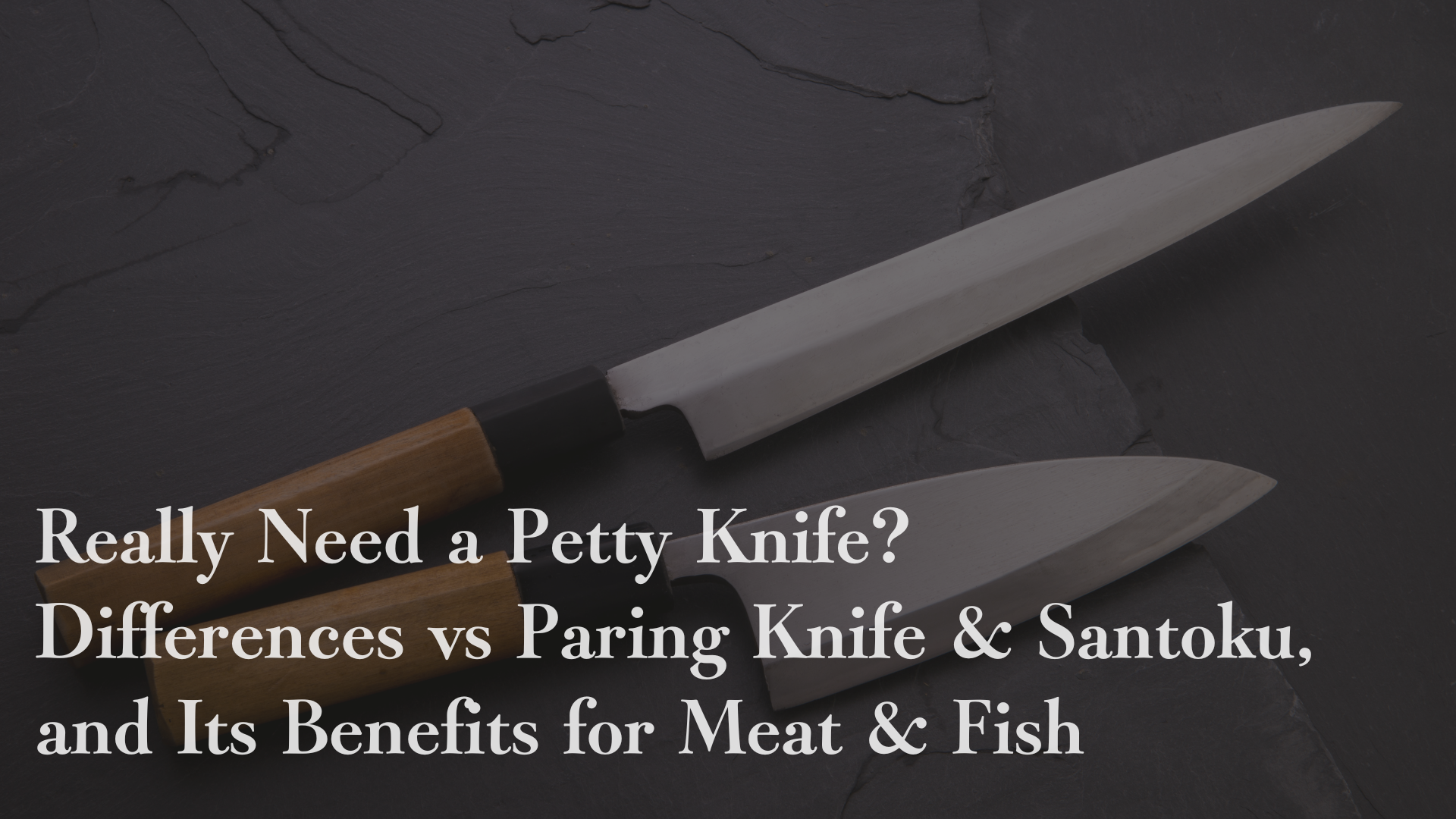
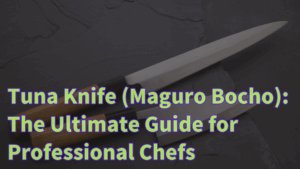

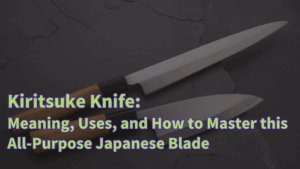



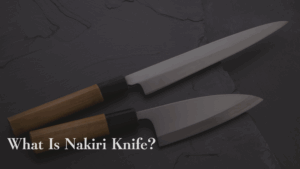

Comments